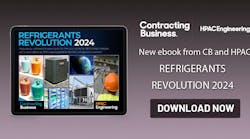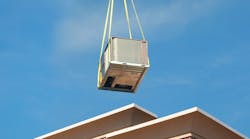Most light-commercial HVAC products are designed for a useful life of 15 to 20 years. During that time, however, the reliability and cost-effectiveness of operation often is dictated by factors beyond the manufacturer’s control. At the same time, newer, more efficient HVAC products often can reduce maintenance and utility costs. When it comes to deciding whether to repair or replace an older rooftop unit, it is important to consider a number of factors, including current condition, age, efficiency, maintenance/repair history, and associated utility costs. This article will discuss the process of making an informed decision.
Evaluate Current Condition
Overall condition provides valuable information about the quality of maintenance equipment has received. Enlist the services of a qualified technician to inspect items such as:
• The cabinetry—it should be intact and fastened properly to minimize air and weather leakage.
• Filters—they should be clean. Clogged or restricted filters markedly reduce a system’s efficiency, increasing internal negative air pressure and pulling dust, dirt, and debris into the unit’s air-circulation system.
• Indoor and outdoor coils—look for evidence of dirt, debris, and physical damage. Bent, damaged, or restricted fins on coils restrict airflow, reducing unit efficiency and increasing operating costs.
Tying an inspection to periodic maintenance or a repair call will save some expense. An inspection should include a complete review of heating and cooling operation, as well as an assessment of airflow, heating temperature rise, and cooling temperature drop to determine whether they are within the manufacturer’s specified ratings. Be present for the inspection, and ask the technician to review the findings, including recommendations and quotes for corrective actions, with you. File this information.
Review Repair and Operating History
Review all available information regarding system operation and upkeep, including utility expenses, as well as installation, maintenance, and repair records. If you do not have this information, contact your utility providers and service contractors, and let them know you are evaluating your equipment to determine whether to replace it. Usually, they help in such situations.
If you do not have a file on each piece of equipment, start one. In addition to the records you collect, be sure to include the manufacturer model and serial numbers, individual unit or site reference number, installation and operating instructions, warranty information, and factory- or contractor-backed service and maintenance agreements.
Assess the Information
Based on the information you have and the inspections you conducted, assess the condition of each unit. Consider the age and condition of the unit, as well as applicable warranties and service contracts. Has the equipment been well-maintained? What repairs will be needed in the short and long terms?
As you review the information you gathered, determine and confirm any manufacturer- and contractor-supported warranty coverage that remains.
Compare current and projected operating costs, as well as projected repair costs, with the operating costs of new high-efficiency equipment. Most manufacturers can aid this comparison by estimating operating costs based on unit efficiency and local utility costs. In many cases, if your equipment is aged, new high-efficiency equipment will provide significant utility savings that can be factored as “payback.” A firm quote from a contractor can help you estimate the costs associated with restoring a unit’s operating performance.
Lastly, as you make your decision to repair or replace, consider possible utility rebates for the installation of high-efficiency equipment. Your local utility can provide rebate information applicable to your area.
Also worth considering are potential savings from new-equipment warranties. Compare them with estimates of out-of-warranty repair costs. Extended-warranty and scheduled-maintenance programs offer additional savings.
Make a Decision
Select a reputable local contractor offering ongoing support. Define maintenance and monitoring requirements. Maintenance and monitoring should apply to all aspects of equipment, be performed regularly, involve accurate record keeping, and include basic system-performance measurements to ensure equipment remains in peak operating condition.
Keep accurate records. These will help you to estimate operating expenses and, in the event of a problem, guide repair work. And as your equipment ages, these records will prove useful as you again consider the question of repair or replace.
David Negrey is the director of UPG Technical Services for Johnson Controls, including the York, Coleman, and Luxaire brands.
Did you find this article useful? Send comments and suggestions to Executive Editor Scott Arnold at [email protected].









